Comprehensive SWOT Analysis of the British Petroleum Company
VerifiedAdded on 2020/06/03
|19
|5860
|44
AI Summary
The purpose of this assignment is to provide students with an opportunity to analyze two significant entities in the financial sector: Bank of America and The Boston Consulting Group (BCG). By performing a SWOT analysis for each organization, students will identify key internal strengths and weaknesses alongside external opportunities and threats. This comparison will highlight differences and similarities in strategic positioning between a major bank and a leading consultancy firm. Students are expected to leverage resources such as the mentioned sources and additional credible materials to enrich their analysis. The assignment aims to enhance understanding of strategic management practices within varying organizational contexts.
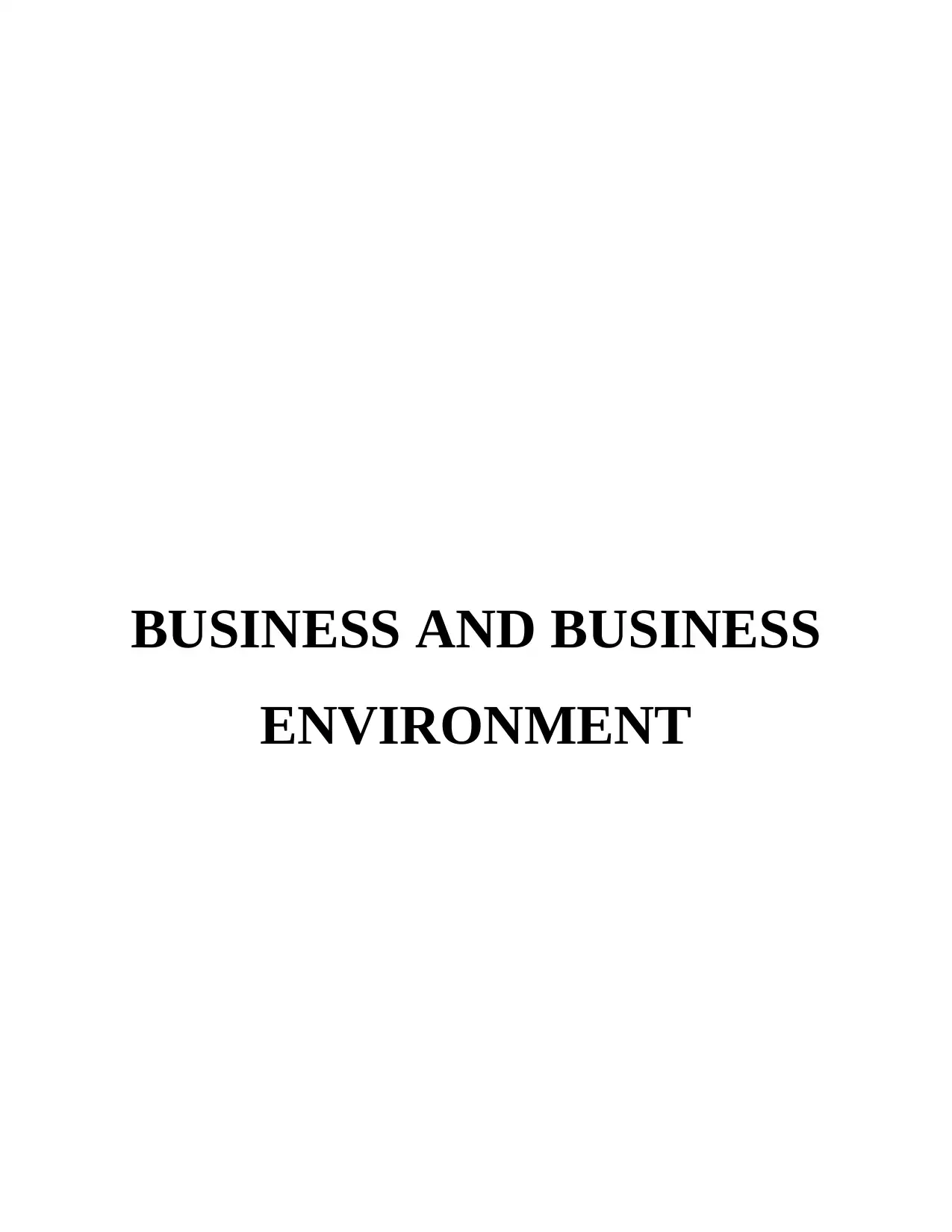
BUSINESS AND BUSINESS
ENVIRONMENT
ENVIRONMENT
Paraphrase This Document
Need a fresh take? Get an instant paraphrase of this document with our AI Paraphraser
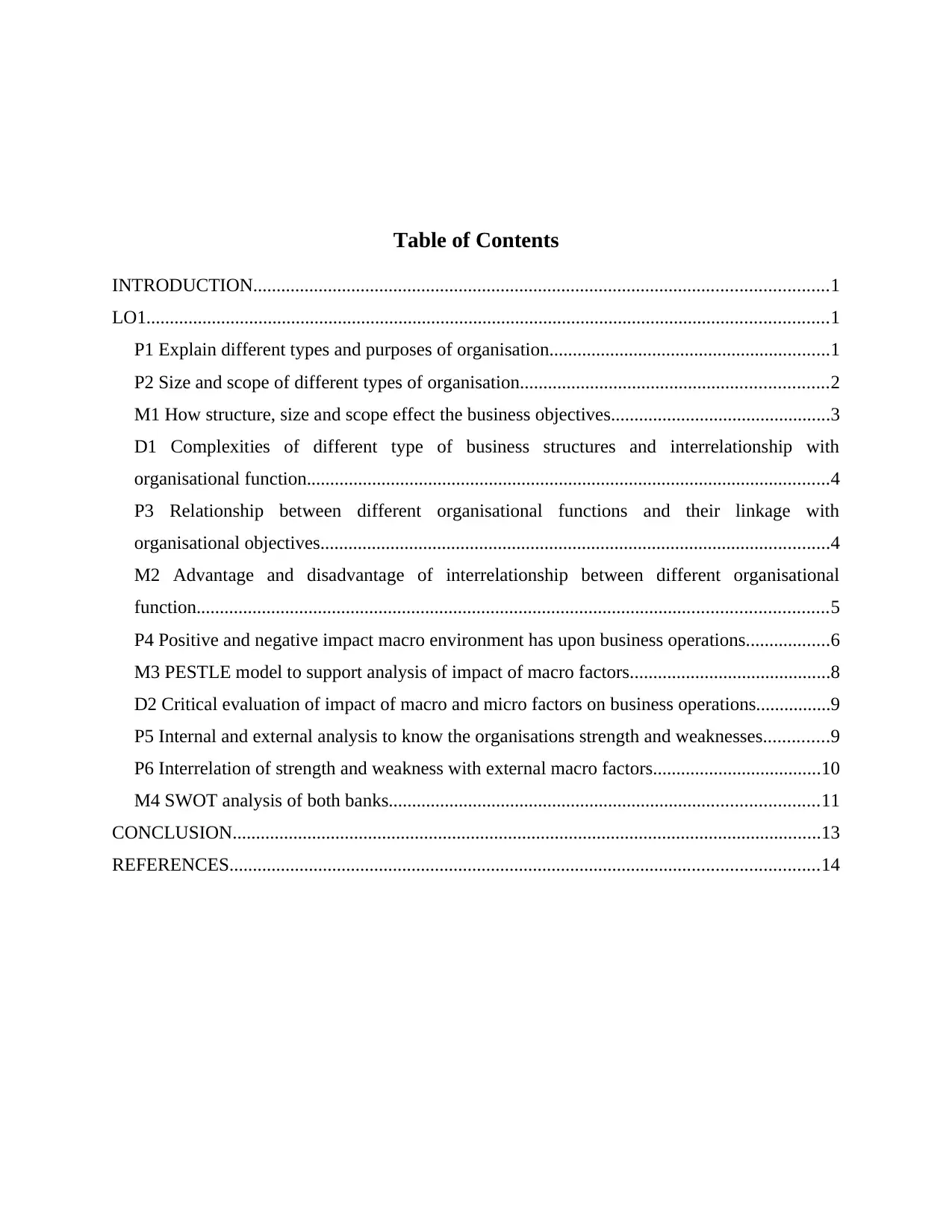
Table of Contents
INTRODUCTION...........................................................................................................................1
LO1..................................................................................................................................................1
P1 Explain different types and purposes of organisation............................................................1
P2 Size and scope of different types of organisation..................................................................2
M1 How structure, size and scope effect the business objectives...............................................3
D1 Complexities of different type of business structures and interrelationship with
organisational function................................................................................................................4
P3 Relationship between different organisational functions and their linkage with
organisational objectives.............................................................................................................4
M2 Advantage and disadvantage of interrelationship between different organisational
function.......................................................................................................................................5
P4 Positive and negative impact macro environment has upon business operations..................6
M3 PESTLE model to support analysis of impact of macro factors...........................................8
D2 Critical evaluation of impact of macro and micro factors on business operations................9
P5 Internal and external analysis to know the organisations strength and weaknesses..............9
P6 Interrelation of strength and weakness with external macro factors....................................10
M4 SWOT analysis of both banks............................................................................................11
CONCLUSION..............................................................................................................................13
REFERENCES..............................................................................................................................14
INTRODUCTION...........................................................................................................................1
LO1..................................................................................................................................................1
P1 Explain different types and purposes of organisation............................................................1
P2 Size and scope of different types of organisation..................................................................2
M1 How structure, size and scope effect the business objectives...............................................3
D1 Complexities of different type of business structures and interrelationship with
organisational function................................................................................................................4
P3 Relationship between different organisational functions and their linkage with
organisational objectives.............................................................................................................4
M2 Advantage and disadvantage of interrelationship between different organisational
function.......................................................................................................................................5
P4 Positive and negative impact macro environment has upon business operations..................6
M3 PESTLE model to support analysis of impact of macro factors...........................................8
D2 Critical evaluation of impact of macro and micro factors on business operations................9
P5 Internal and external analysis to know the organisations strength and weaknesses..............9
P6 Interrelation of strength and weakness with external macro factors....................................10
M4 SWOT analysis of both banks............................................................................................11
CONCLUSION..............................................................................................................................13
REFERENCES..............................................................................................................................14

⊘ This is a preview!⊘
Do you want full access?
Subscribe today to unlock all pages.

Trusted by 1+ million students worldwide
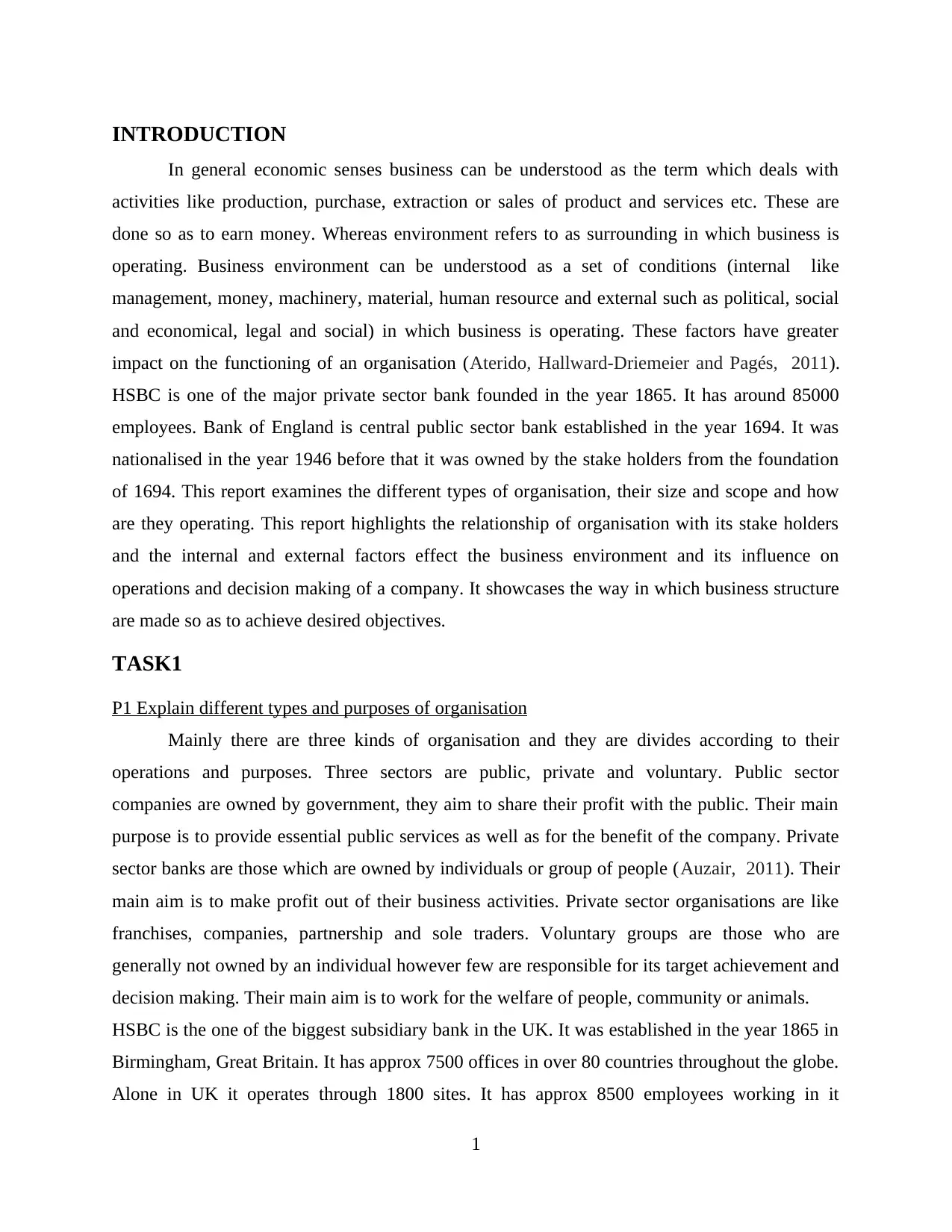
INTRODUCTION
In general economic senses business can be understood as the term which deals with
activities like production, purchase, extraction or sales of product and services etc. These are
done so as to earn money. Whereas environment refers to as surrounding in which business is
operating. Business environment can be understood as a set of conditions (internal like
management, money, machinery, material, human resource and external such as political, social
and economical, legal and social) in which business is operating. These factors have greater
impact on the functioning of an organisation (Aterido, Hallward-Driemeier and Pagés, 2011).
HSBC is one of the major private sector bank founded in the year 1865. It has around 85000
employees. Bank of England is central public sector bank established in the year 1694. It was
nationalised in the year 1946 before that it was owned by the stake holders from the foundation
of 1694. This report examines the different types of organisation, their size and scope and how
are they operating. This report highlights the relationship of organisation with its stake holders
and the internal and external factors effect the business environment and its influence on
operations and decision making of a company. It showcases the way in which business structure
are made so as to achieve desired objectives.
TASK1
P1 Explain different types and purposes of organisation
Mainly there are three kinds of organisation and they are divides according to their
operations and purposes. Three sectors are public, private and voluntary. Public sector
companies are owned by government, they aim to share their profit with the public. Their main
purpose is to provide essential public services as well as for the benefit of the company. Private
sector banks are those which are owned by individuals or group of people (Auzair, 2011). Their
main aim is to make profit out of their business activities. Private sector organisations are like
franchises, companies, partnership and sole traders. Voluntary groups are those who are
generally not owned by an individual however few are responsible for its target achievement and
decision making. Their main aim is to work for the welfare of people, community or animals.
HSBC is the one of the biggest subsidiary bank in the UK. It was established in the year 1865 in
Birmingham, Great Britain. It has approx 7500 offices in over 80 countries throughout the globe.
Alone in UK it operates through 1800 sites. It has approx 8500 employees working in it
1
In general economic senses business can be understood as the term which deals with
activities like production, purchase, extraction or sales of product and services etc. These are
done so as to earn money. Whereas environment refers to as surrounding in which business is
operating. Business environment can be understood as a set of conditions (internal like
management, money, machinery, material, human resource and external such as political, social
and economical, legal and social) in which business is operating. These factors have greater
impact on the functioning of an organisation (Aterido, Hallward-Driemeier and Pagés, 2011).
HSBC is one of the major private sector bank founded in the year 1865. It has around 85000
employees. Bank of England is central public sector bank established in the year 1694. It was
nationalised in the year 1946 before that it was owned by the stake holders from the foundation
of 1694. This report examines the different types of organisation, their size and scope and how
are they operating. This report highlights the relationship of organisation with its stake holders
and the internal and external factors effect the business environment and its influence on
operations and decision making of a company. It showcases the way in which business structure
are made so as to achieve desired objectives.
TASK1
P1 Explain different types and purposes of organisation
Mainly there are three kinds of organisation and they are divides according to their
operations and purposes. Three sectors are public, private and voluntary. Public sector
companies are owned by government, they aim to share their profit with the public. Their main
purpose is to provide essential public services as well as for the benefit of the company. Private
sector banks are those which are owned by individuals or group of people (Auzair, 2011). Their
main aim is to make profit out of their business activities. Private sector organisations are like
franchises, companies, partnership and sole traders. Voluntary groups are those who are
generally not owned by an individual however few are responsible for its target achievement and
decision making. Their main aim is to work for the welfare of people, community or animals.
HSBC is the one of the biggest subsidiary bank in the UK. It was established in the year 1865 in
Birmingham, Great Britain. It has approx 7500 offices in over 80 countries throughout the globe.
Alone in UK it operates through 1800 sites. It has approx 8500 employees working in it
1
Paraphrase This Document
Need a fresh take? Get an instant paraphrase of this document with our AI Paraphraser
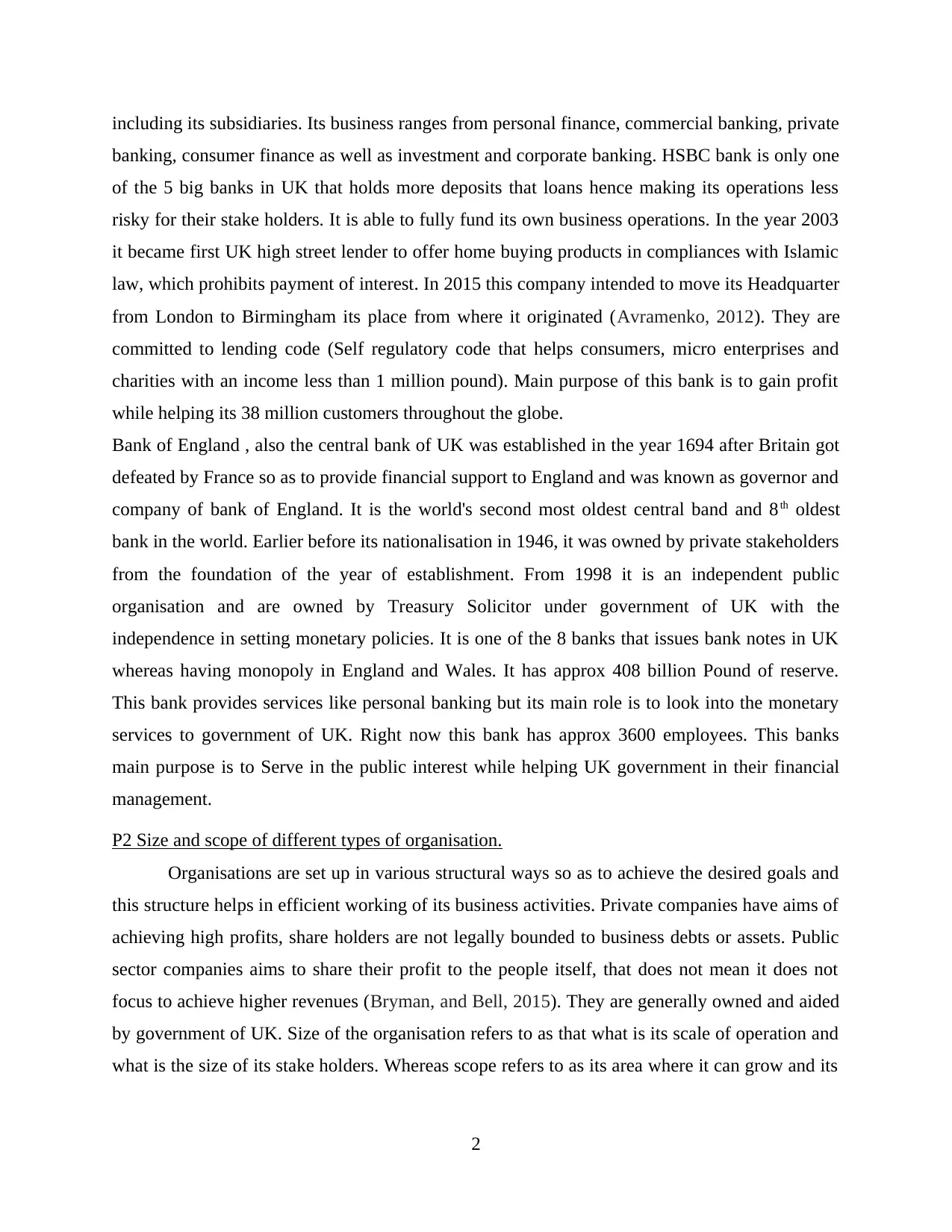
including its subsidiaries. Its business ranges from personal finance, commercial banking, private
banking, consumer finance as well as investment and corporate banking. HSBC bank is only one
of the 5 big banks in UK that holds more deposits that loans hence making its operations less
risky for their stake holders. It is able to fully fund its own business operations. In the year 2003
it became first UK high street lender to offer home buying products in compliances with Islamic
law, which prohibits payment of interest. In 2015 this company intended to move its Headquarter
from London to Birmingham its place from where it originated (Avramenko, 2012). They are
committed to lending code (Self regulatory code that helps consumers, micro enterprises and
charities with an income less than 1 million pound). Main purpose of this bank is to gain profit
while helping its 38 million customers throughout the globe.
Bank of England , also the central bank of UK was established in the year 1694 after Britain got
defeated by France so as to provide financial support to England and was known as governor and
company of bank of England. It is the world's second most oldest central band and 8th oldest
bank in the world. Earlier before its nationalisation in 1946, it was owned by private stakeholders
from the foundation of the year of establishment. From 1998 it is an independent public
organisation and are owned by Treasury Solicitor under government of UK with the
independence in setting monetary policies. It is one of the 8 banks that issues bank notes in UK
whereas having monopoly in England and Wales. It has approx 408 billion Pound of reserve.
This bank provides services like personal banking but its main role is to look into the monetary
services to government of UK. Right now this bank has approx 3600 employees. This banks
main purpose is to Serve in the public interest while helping UK government in their financial
management.
P2 Size and scope of different types of organisation.
Organisations are set up in various structural ways so as to achieve the desired goals and
this structure helps in efficient working of its business activities. Private companies have aims of
achieving high profits, share holders are not legally bounded to business debts or assets. Public
sector companies aims to share their profit to the people itself, that does not mean it does not
focus to achieve higher revenues (Bryman, and Bell, 2015). They are generally owned and aided
by government of UK. Size of the organisation refers to as that what is its scale of operation and
what is the size of its stake holders. Whereas scope refers to as its area where it can grow and its
2
banking, consumer finance as well as investment and corporate banking. HSBC bank is only one
of the 5 big banks in UK that holds more deposits that loans hence making its operations less
risky for their stake holders. It is able to fully fund its own business operations. In the year 2003
it became first UK high street lender to offer home buying products in compliances with Islamic
law, which prohibits payment of interest. In 2015 this company intended to move its Headquarter
from London to Birmingham its place from where it originated (Avramenko, 2012). They are
committed to lending code (Self regulatory code that helps consumers, micro enterprises and
charities with an income less than 1 million pound). Main purpose of this bank is to gain profit
while helping its 38 million customers throughout the globe.
Bank of England , also the central bank of UK was established in the year 1694 after Britain got
defeated by France so as to provide financial support to England and was known as governor and
company of bank of England. It is the world's second most oldest central band and 8th oldest
bank in the world. Earlier before its nationalisation in 1946, it was owned by private stakeholders
from the foundation of the year of establishment. From 1998 it is an independent public
organisation and are owned by Treasury Solicitor under government of UK with the
independence in setting monetary policies. It is one of the 8 banks that issues bank notes in UK
whereas having monopoly in England and Wales. It has approx 408 billion Pound of reserve.
This bank provides services like personal banking but its main role is to look into the monetary
services to government of UK. Right now this bank has approx 3600 employees. This banks
main purpose is to Serve in the public interest while helping UK government in their financial
management.
P2 Size and scope of different types of organisation.
Organisations are set up in various structural ways so as to achieve the desired goals and
this structure helps in efficient working of its business activities. Private companies have aims of
achieving high profits, share holders are not legally bounded to business debts or assets. Public
sector companies aims to share their profit to the people itself, that does not mean it does not
focus to achieve higher revenues (Bryman, and Bell, 2015). They are generally owned and aided
by government of UK. Size of the organisation refers to as that what is its scale of operation and
what is the size of its stake holders. Whereas scope refers to as its area where it can grow and its
2
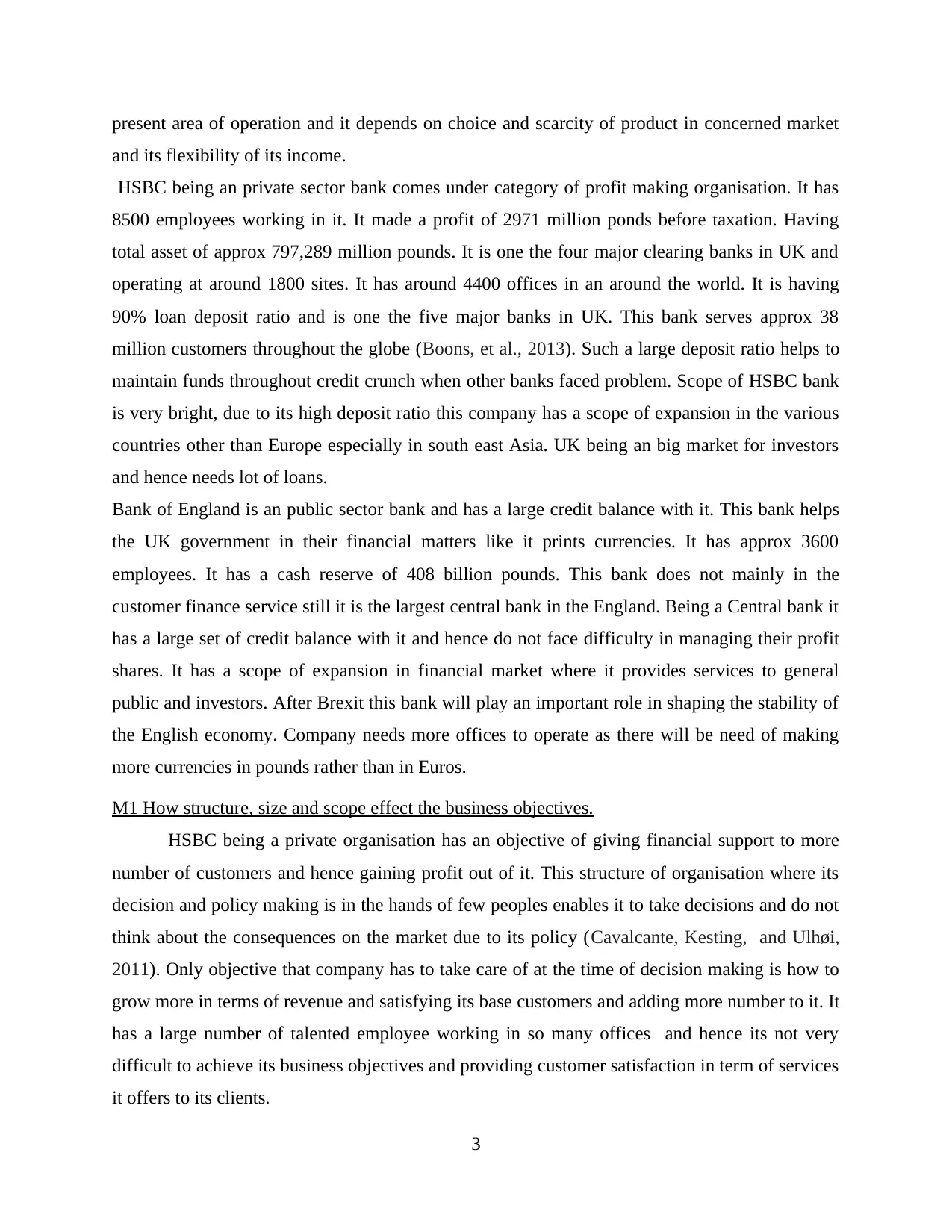
present area of operation and it depends on choice and scarcity of product in concerned market
and its flexibility of its income.
HSBC being an private sector bank comes under category of profit making organisation. It has
8500 employees working in it. It made a profit of 2971 million ponds before taxation. Having
total asset of approx 797,289 million pounds. It is one the four major clearing banks in UK and
operating at around 1800 sites. It has around 4400 offices in an around the world. It is having
90% loan deposit ratio and is one the five major banks in UK. This bank serves approx 38
million customers throughout the globe (Boons, et al., 2013). Such a large deposit ratio helps to
maintain funds throughout credit crunch when other banks faced problem. Scope of HSBC bank
is very bright, due to its high deposit ratio this company has a scope of expansion in the various
countries other than Europe especially in south east Asia. UK being an big market for investors
and hence needs lot of loans.
Bank of England is an public sector bank and has a large credit balance with it. This bank helps
the UK government in their financial matters like it prints currencies. It has approx 3600
employees. It has a cash reserve of 408 billion pounds. This bank does not mainly in the
customer finance service still it is the largest central bank in the England. Being a Central bank it
has a large set of credit balance with it and hence do not face difficulty in managing their profit
shares. It has a scope of expansion in financial market where it provides services to general
public and investors. After Brexit this bank will play an important role in shaping the stability of
the English economy. Company needs more offices to operate as there will be need of making
more currencies in pounds rather than in Euros.
M1 How structure, size and scope effect the business objectives.
HSBC being a private organisation has an objective of giving financial support to more
number of customers and hence gaining profit out of it. This structure of organisation where its
decision and policy making is in the hands of few peoples enables it to take decisions and do not
think about the consequences on the market due to its policy (Cavalcante, Kesting, and Ulhøi,
2011). Only objective that company has to take care of at the time of decision making is how to
grow more in terms of revenue and satisfying its base customers and adding more number to it. It
has a large number of talented employee working in so many offices and hence its not very
difficult to achieve its business objectives and providing customer satisfaction in term of services
it offers to its clients.
3
and its flexibility of its income.
HSBC being an private sector bank comes under category of profit making organisation. It has
8500 employees working in it. It made a profit of 2971 million ponds before taxation. Having
total asset of approx 797,289 million pounds. It is one the four major clearing banks in UK and
operating at around 1800 sites. It has around 4400 offices in an around the world. It is having
90% loan deposit ratio and is one the five major banks in UK. This bank serves approx 38
million customers throughout the globe (Boons, et al., 2013). Such a large deposit ratio helps to
maintain funds throughout credit crunch when other banks faced problem. Scope of HSBC bank
is very bright, due to its high deposit ratio this company has a scope of expansion in the various
countries other than Europe especially in south east Asia. UK being an big market for investors
and hence needs lot of loans.
Bank of England is an public sector bank and has a large credit balance with it. This bank helps
the UK government in their financial matters like it prints currencies. It has approx 3600
employees. It has a cash reserve of 408 billion pounds. This bank does not mainly in the
customer finance service still it is the largest central bank in the England. Being a Central bank it
has a large set of credit balance with it and hence do not face difficulty in managing their profit
shares. It has a scope of expansion in financial market where it provides services to general
public and investors. After Brexit this bank will play an important role in shaping the stability of
the English economy. Company needs more offices to operate as there will be need of making
more currencies in pounds rather than in Euros.
M1 How structure, size and scope effect the business objectives.
HSBC being a private organisation has an objective of giving financial support to more
number of customers and hence gaining profit out of it. This structure of organisation where its
decision and policy making is in the hands of few peoples enables it to take decisions and do not
think about the consequences on the market due to its policy (Cavalcante, Kesting, and Ulhøi,
2011). Only objective that company has to take care of at the time of decision making is how to
grow more in terms of revenue and satisfying its base customers and adding more number to it. It
has a large number of talented employee working in so many offices and hence its not very
difficult to achieve its business objectives and providing customer satisfaction in term of services
it offers to its clients.
3
⊘ This is a preview!⊘
Do you want full access?
Subscribe today to unlock all pages.

Trusted by 1+ million students worldwide
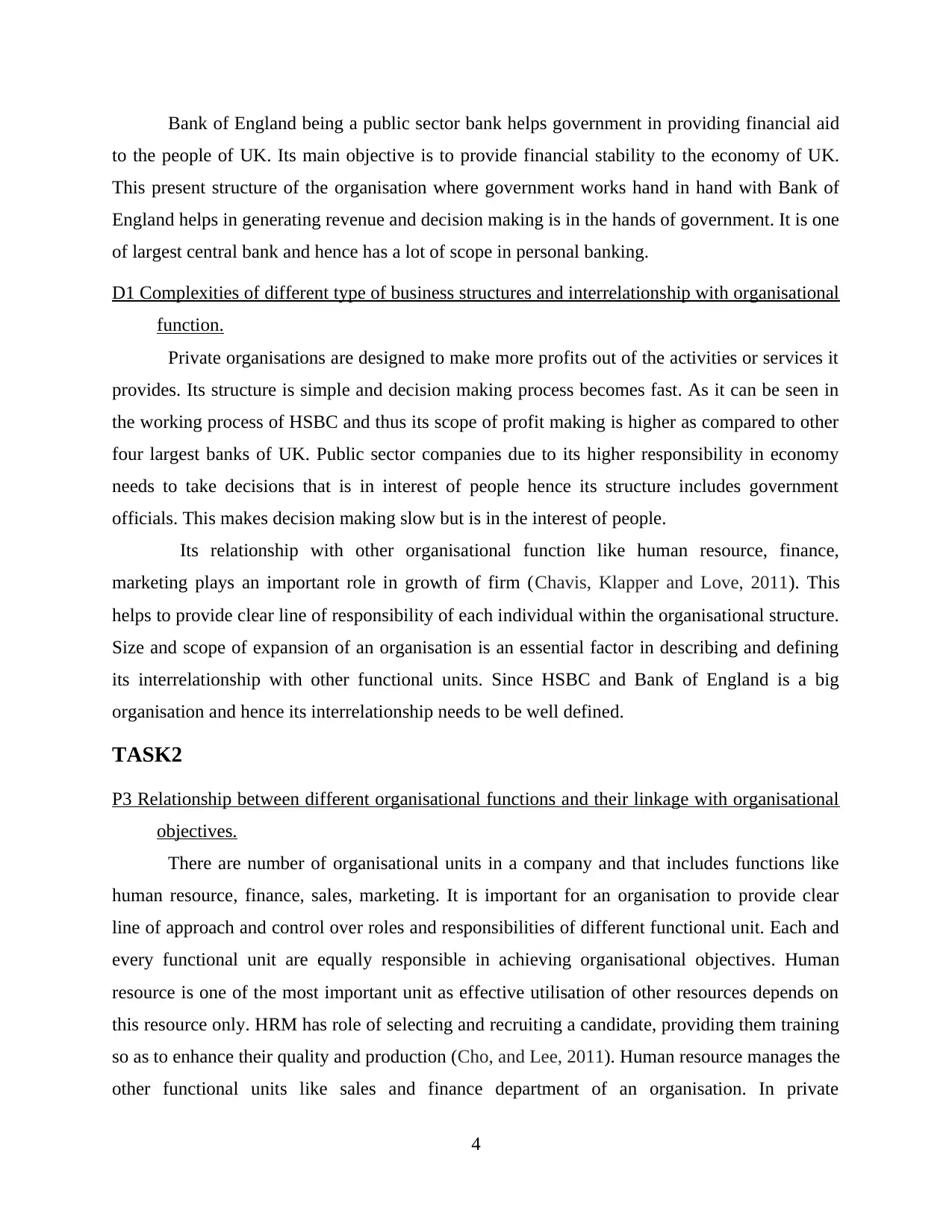
Bank of England being a public sector bank helps government in providing financial aid
to the people of UK. Its main objective is to provide financial stability to the economy of UK.
This present structure of the organisation where government works hand in hand with Bank of
England helps in generating revenue and decision making is in the hands of government. It is one
of largest central bank and hence has a lot of scope in personal banking.
D1 Complexities of different type of business structures and interrelationship with organisational
function.
Private organisations are designed to make more profits out of the activities or services it
provides. Its structure is simple and decision making process becomes fast. As it can be seen in
the working process of HSBC and thus its scope of profit making is higher as compared to other
four largest banks of UK. Public sector companies due to its higher responsibility in economy
needs to take decisions that is in interest of people hence its structure includes government
officials. This makes decision making slow but is in the interest of people.
Its relationship with other organisational function like human resource, finance,
marketing plays an important role in growth of firm (Chavis, Klapper and Love, 2011). This
helps to provide clear line of responsibility of each individual within the organisational structure.
Size and scope of expansion of an organisation is an essential factor in describing and defining
its interrelationship with other functional units. Since HSBC and Bank of England is a big
organisation and hence its interrelationship needs to be well defined.
TASK2
P3 Relationship between different organisational functions and their linkage with organisational
objectives.
There are number of organisational units in a company and that includes functions like
human resource, finance, sales, marketing. It is important for an organisation to provide clear
line of approach and control over roles and responsibilities of different functional unit. Each and
every functional unit are equally responsible in achieving organisational objectives. Human
resource is one of the most important unit as effective utilisation of other resources depends on
this resource only. HRM has role of selecting and recruiting a candidate, providing them training
so as to enhance their quality and production (Cho, and Lee, 2011). Human resource manages the
other functional units like sales and finance department of an organisation. In private
4
to the people of UK. Its main objective is to provide financial stability to the economy of UK.
This present structure of the organisation where government works hand in hand with Bank of
England helps in generating revenue and decision making is in the hands of government. It is one
of largest central bank and hence has a lot of scope in personal banking.
D1 Complexities of different type of business structures and interrelationship with organisational
function.
Private organisations are designed to make more profits out of the activities or services it
provides. Its structure is simple and decision making process becomes fast. As it can be seen in
the working process of HSBC and thus its scope of profit making is higher as compared to other
four largest banks of UK. Public sector companies due to its higher responsibility in economy
needs to take decisions that is in interest of people hence its structure includes government
officials. This makes decision making slow but is in the interest of people.
Its relationship with other organisational function like human resource, finance,
marketing plays an important role in growth of firm (Chavis, Klapper and Love, 2011). This
helps to provide clear line of responsibility of each individual within the organisational structure.
Size and scope of expansion of an organisation is an essential factor in describing and defining
its interrelationship with other functional units. Since HSBC and Bank of England is a big
organisation and hence its interrelationship needs to be well defined.
TASK2
P3 Relationship between different organisational functions and their linkage with organisational
objectives.
There are number of organisational units in a company and that includes functions like
human resource, finance, sales, marketing. It is important for an organisation to provide clear
line of approach and control over roles and responsibilities of different functional unit. Each and
every functional unit are equally responsible in achieving organisational objectives. Human
resource is one of the most important unit as effective utilisation of other resources depends on
this resource only. HRM has role of selecting and recruiting a candidate, providing them training
so as to enhance their quality and production (Cho, and Lee, 2011). Human resource manages the
other functional units like sales and finance department of an organisation. In private
4
Paraphrase This Document
Need a fresh take? Get an instant paraphrase of this document with our AI Paraphraser
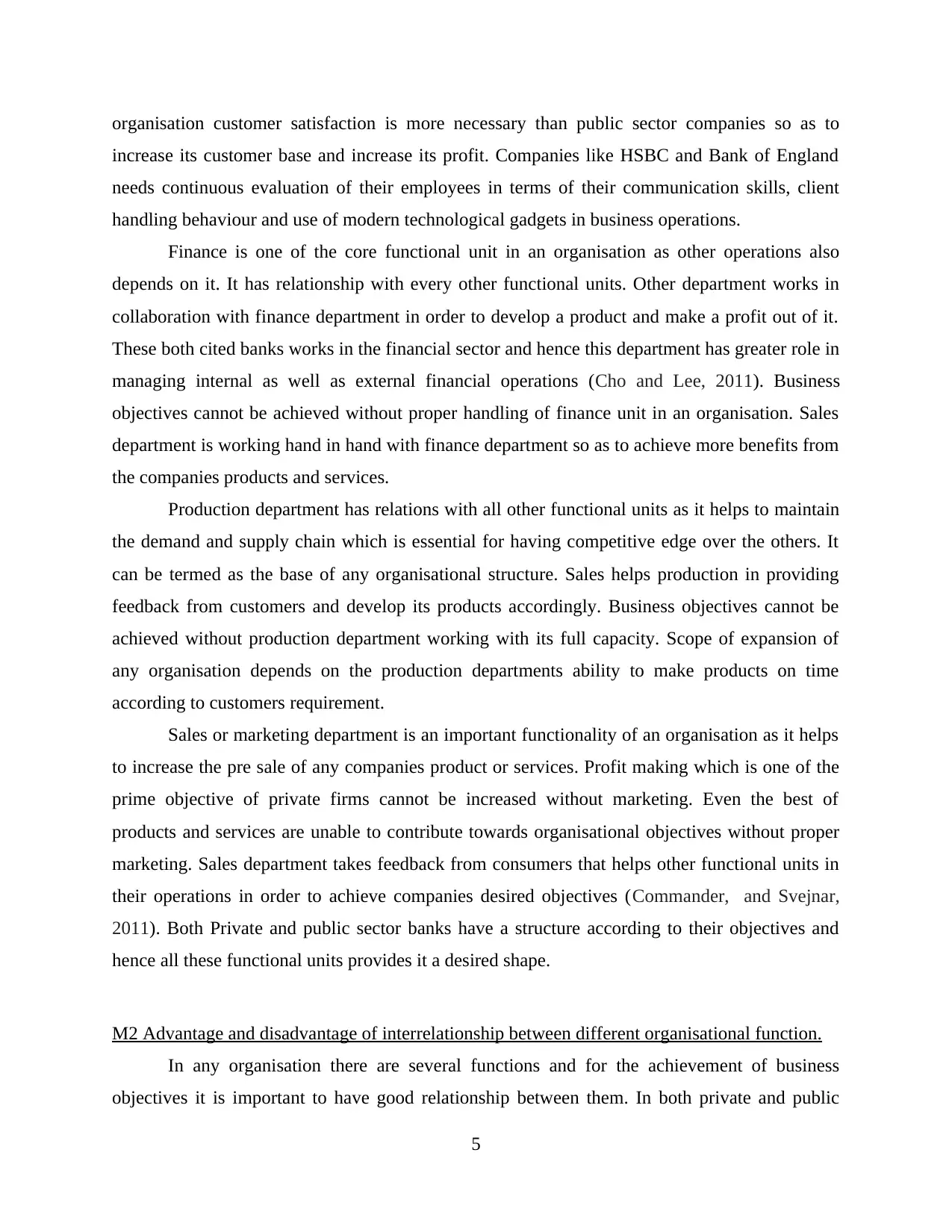
organisation customer satisfaction is more necessary than public sector companies so as to
increase its customer base and increase its profit. Companies like HSBC and Bank of England
needs continuous evaluation of their employees in terms of their communication skills, client
handling behaviour and use of modern technological gadgets in business operations.
Finance is one of the core functional unit in an organisation as other operations also
depends on it. It has relationship with every other functional units. Other department works in
collaboration with finance department in order to develop a product and make a profit out of it.
These both cited banks works in the financial sector and hence this department has greater role in
managing internal as well as external financial operations (Cho and Lee, 2011). Business
objectives cannot be achieved without proper handling of finance unit in an organisation. Sales
department is working hand in hand with finance department so as to achieve more benefits from
the companies products and services.
Production department has relations with all other functional units as it helps to maintain
the demand and supply chain which is essential for having competitive edge over the others. It
can be termed as the base of any organisational structure. Sales helps production in providing
feedback from customers and develop its products accordingly. Business objectives cannot be
achieved without production department working with its full capacity. Scope of expansion of
any organisation depends on the production departments ability to make products on time
according to customers requirement.
Sales or marketing department is an important functionality of an organisation as it helps
to increase the pre sale of any companies product or services. Profit making which is one of the
prime objective of private firms cannot be increased without marketing. Even the best of
products and services are unable to contribute towards organisational objectives without proper
marketing. Sales department takes feedback from consumers that helps other functional units in
their operations in order to achieve companies desired objectives (Commander, and Svejnar,
2011). Both Private and public sector banks have a structure according to their objectives and
hence all these functional units provides it a desired shape.
M2 Advantage and disadvantage of interrelationship between different organisational function.
In any organisation there are several functions and for the achievement of business
objectives it is important to have good relationship between them. In both private and public
5
increase its customer base and increase its profit. Companies like HSBC and Bank of England
needs continuous evaluation of their employees in terms of their communication skills, client
handling behaviour and use of modern technological gadgets in business operations.
Finance is one of the core functional unit in an organisation as other operations also
depends on it. It has relationship with every other functional units. Other department works in
collaboration with finance department in order to develop a product and make a profit out of it.
These both cited banks works in the financial sector and hence this department has greater role in
managing internal as well as external financial operations (Cho and Lee, 2011). Business
objectives cannot be achieved without proper handling of finance unit in an organisation. Sales
department is working hand in hand with finance department so as to achieve more benefits from
the companies products and services.
Production department has relations with all other functional units as it helps to maintain
the demand and supply chain which is essential for having competitive edge over the others. It
can be termed as the base of any organisational structure. Sales helps production in providing
feedback from customers and develop its products accordingly. Business objectives cannot be
achieved without production department working with its full capacity. Scope of expansion of
any organisation depends on the production departments ability to make products on time
according to customers requirement.
Sales or marketing department is an important functionality of an organisation as it helps
to increase the pre sale of any companies product or services. Profit making which is one of the
prime objective of private firms cannot be increased without marketing. Even the best of
products and services are unable to contribute towards organisational objectives without proper
marketing. Sales department takes feedback from consumers that helps other functional units in
their operations in order to achieve companies desired objectives (Commander, and Svejnar,
2011). Both Private and public sector banks have a structure according to their objectives and
hence all these functional units provides it a desired shape.
M2 Advantage and disadvantage of interrelationship between different organisational function.
In any organisation there are several functions and for the achievement of business
objectives it is important to have good relationship between them. In both private and public
5
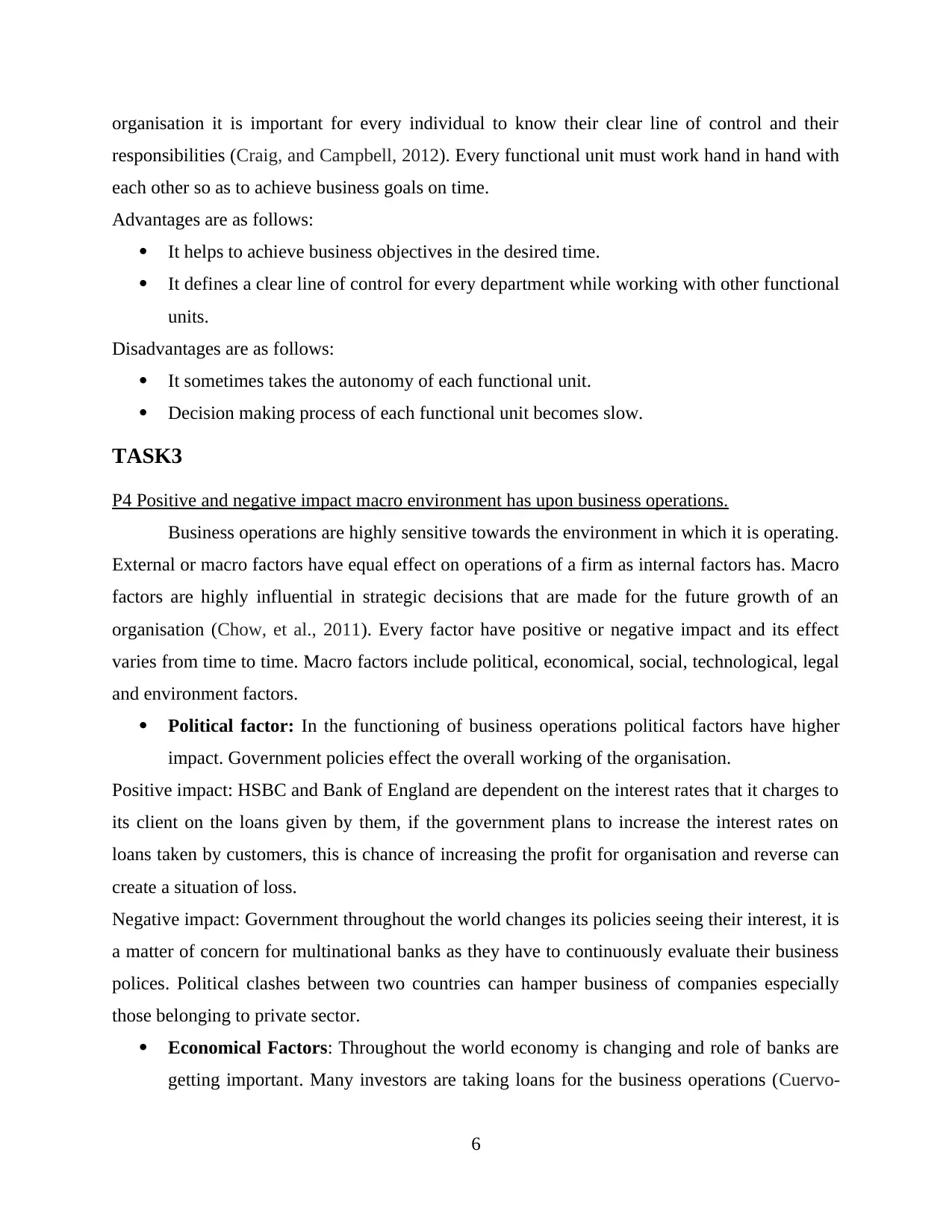
organisation it is important for every individual to know their clear line of control and their
responsibilities (Craig, and Campbell, 2012). Every functional unit must work hand in hand with
each other so as to achieve business goals on time.
Advantages are as follows:
It helps to achieve business objectives in the desired time.
It defines a clear line of control for every department while working with other functional
units.
Disadvantages are as follows:
It sometimes takes the autonomy of each functional unit.
Decision making process of each functional unit becomes slow.
TASK3
P4 Positive and negative impact macro environment has upon business operations.
Business operations are highly sensitive towards the environment in which it is operating.
External or macro factors have equal effect on operations of a firm as internal factors has. Macro
factors are highly influential in strategic decisions that are made for the future growth of an
organisation (Chow, et al., 2011). Every factor have positive or negative impact and its effect
varies from time to time. Macro factors include political, economical, social, technological, legal
and environment factors.
Political factor: In the functioning of business operations political factors have higher
impact. Government policies effect the overall working of the organisation.
Positive impact: HSBC and Bank of England are dependent on the interest rates that it charges to
its client on the loans given by them, if the government plans to increase the interest rates on
loans taken by customers, this is chance of increasing the profit for organisation and reverse can
create a situation of loss.
Negative impact: Government throughout the world changes its policies seeing their interest, it is
a matter of concern for multinational banks as they have to continuously evaluate their business
polices. Political clashes between two countries can hamper business of companies especially
those belonging to private sector.
Economical Factors: Throughout the world economy is changing and role of banks are
getting important. Many investors are taking loans for the business operations (Cuervo‐
6
responsibilities (Craig, and Campbell, 2012). Every functional unit must work hand in hand with
each other so as to achieve business goals on time.
Advantages are as follows:
It helps to achieve business objectives in the desired time.
It defines a clear line of control for every department while working with other functional
units.
Disadvantages are as follows:
It sometimes takes the autonomy of each functional unit.
Decision making process of each functional unit becomes slow.
TASK3
P4 Positive and negative impact macro environment has upon business operations.
Business operations are highly sensitive towards the environment in which it is operating.
External or macro factors have equal effect on operations of a firm as internal factors has. Macro
factors are highly influential in strategic decisions that are made for the future growth of an
organisation (Chow, et al., 2011). Every factor have positive or negative impact and its effect
varies from time to time. Macro factors include political, economical, social, technological, legal
and environment factors.
Political factor: In the functioning of business operations political factors have higher
impact. Government policies effect the overall working of the organisation.
Positive impact: HSBC and Bank of England are dependent on the interest rates that it charges to
its client on the loans given by them, if the government plans to increase the interest rates on
loans taken by customers, this is chance of increasing the profit for organisation and reverse can
create a situation of loss.
Negative impact: Government throughout the world changes its policies seeing their interest, it is
a matter of concern for multinational banks as they have to continuously evaluate their business
polices. Political clashes between two countries can hamper business of companies especially
those belonging to private sector.
Economical Factors: Throughout the world economy is changing and role of banks are
getting important. Many investors are taking loans for the business operations (Cuervo‐
6
⊘ This is a preview!⊘
Do you want full access?
Subscribe today to unlock all pages.

Trusted by 1+ million students worldwide
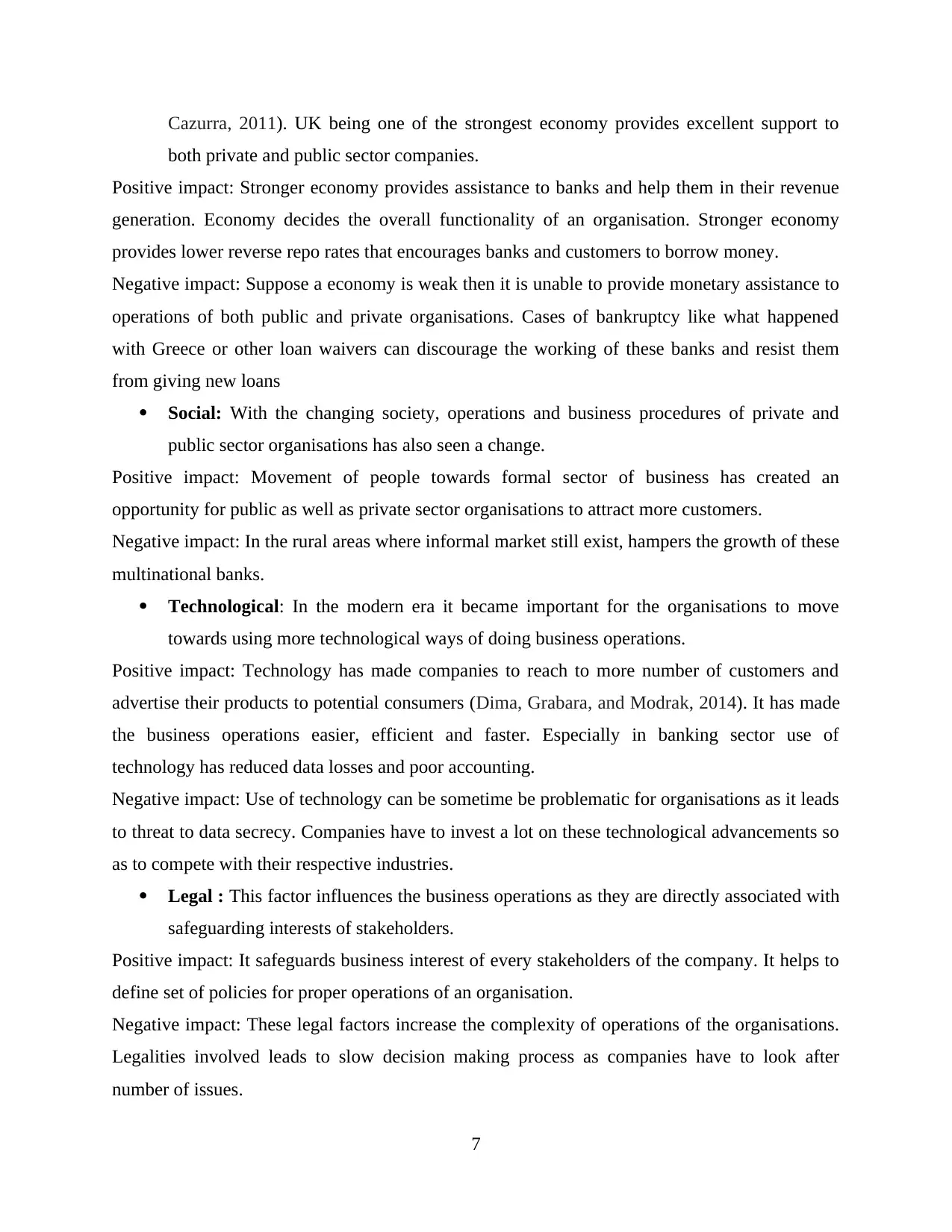
Cazurra, 2011). UK being one of the strongest economy provides excellent support to
both private and public sector companies.
Positive impact: Stronger economy provides assistance to banks and help them in their revenue
generation. Economy decides the overall functionality of an organisation. Stronger economy
provides lower reverse repo rates that encourages banks and customers to borrow money.
Negative impact: Suppose a economy is weak then it is unable to provide monetary assistance to
operations of both public and private organisations. Cases of bankruptcy like what happened
with Greece or other loan waivers can discourage the working of these banks and resist them
from giving new loans
Social: With the changing society, operations and business procedures of private and
public sector organisations has also seen a change.
Positive impact: Movement of people towards formal sector of business has created an
opportunity for public as well as private sector organisations to attract more customers.
Negative impact: In the rural areas where informal market still exist, hampers the growth of these
multinational banks.
Technological: In the modern era it became important for the organisations to move
towards using more technological ways of doing business operations.
Positive impact: Technology has made companies to reach to more number of customers and
advertise their products to potential consumers (Dima, Grabara, and Modrak, 2014). It has made
the business operations easier, efficient and faster. Especially in banking sector use of
technology has reduced data losses and poor accounting.
Negative impact: Use of technology can be sometime be problematic for organisations as it leads
to threat to data secrecy. Companies have to invest a lot on these technological advancements so
as to compete with their respective industries.
Legal : This factor influences the business operations as they are directly associated with
safeguarding interests of stakeholders.
Positive impact: It safeguards business interest of every stakeholders of the company. It helps to
define set of policies for proper operations of an organisation.
Negative impact: These legal factors increase the complexity of operations of the organisations.
Legalities involved leads to slow decision making process as companies have to look after
number of issues.
7
both private and public sector companies.
Positive impact: Stronger economy provides assistance to banks and help them in their revenue
generation. Economy decides the overall functionality of an organisation. Stronger economy
provides lower reverse repo rates that encourages banks and customers to borrow money.
Negative impact: Suppose a economy is weak then it is unable to provide monetary assistance to
operations of both public and private organisations. Cases of bankruptcy like what happened
with Greece or other loan waivers can discourage the working of these banks and resist them
from giving new loans
Social: With the changing society, operations and business procedures of private and
public sector organisations has also seen a change.
Positive impact: Movement of people towards formal sector of business has created an
opportunity for public as well as private sector organisations to attract more customers.
Negative impact: In the rural areas where informal market still exist, hampers the growth of these
multinational banks.
Technological: In the modern era it became important for the organisations to move
towards using more technological ways of doing business operations.
Positive impact: Technology has made companies to reach to more number of customers and
advertise their products to potential consumers (Dima, Grabara, and Modrak, 2014). It has made
the business operations easier, efficient and faster. Especially in banking sector use of
technology has reduced data losses and poor accounting.
Negative impact: Use of technology can be sometime be problematic for organisations as it leads
to threat to data secrecy. Companies have to invest a lot on these technological advancements so
as to compete with their respective industries.
Legal : This factor influences the business operations as they are directly associated with
safeguarding interests of stakeholders.
Positive impact: It safeguards business interest of every stakeholders of the company. It helps to
define set of policies for proper operations of an organisation.
Negative impact: These legal factors increase the complexity of operations of the organisations.
Legalities involved leads to slow decision making process as companies have to look after
number of issues.
7
Paraphrase This Document
Need a fresh take? Get an instant paraphrase of this document with our AI Paraphraser
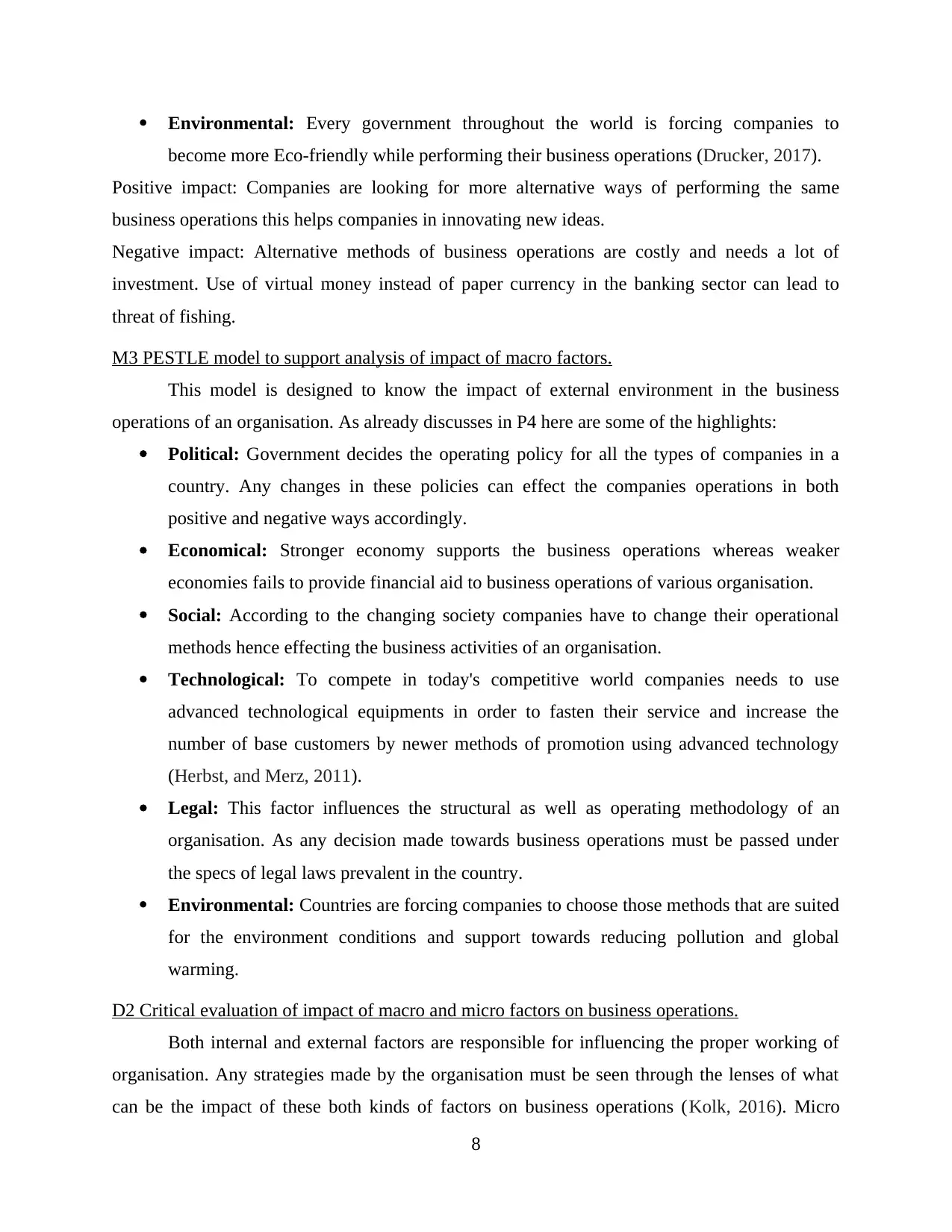
Environmental: Every government throughout the world is forcing companies to
become more Eco-friendly while performing their business operations (Drucker, 2017).
Positive impact: Companies are looking for more alternative ways of performing the same
business operations this helps companies in innovating new ideas.
Negative impact: Alternative methods of business operations are costly and needs a lot of
investment. Use of virtual money instead of paper currency in the banking sector can lead to
threat of fishing.
M3 PESTLE model to support analysis of impact of macro factors.
This model is designed to know the impact of external environment in the business
operations of an organisation. As already discusses in P4 here are some of the highlights:
Political: Government decides the operating policy for all the types of companies in a
country. Any changes in these policies can effect the companies operations in both
positive and negative ways accordingly.
Economical: Stronger economy supports the business operations whereas weaker
economies fails to provide financial aid to business operations of various organisation.
Social: According to the changing society companies have to change their operational
methods hence effecting the business activities of an organisation.
Technological: To compete in today's competitive world companies needs to use
advanced technological equipments in order to fasten their service and increase the
number of base customers by newer methods of promotion using advanced technology
(Herbst, and Merz, 2011).
Legal: This factor influences the structural as well as operating methodology of an
organisation. As any decision made towards business operations must be passed under
the specs of legal laws prevalent in the country.
Environmental: Countries are forcing companies to choose those methods that are suited
for the environment conditions and support towards reducing pollution and global
warming.
D2 Critical evaluation of impact of macro and micro factors on business operations.
Both internal and external factors are responsible for influencing the proper working of
organisation. Any strategies made by the organisation must be seen through the lenses of what
can be the impact of these both kinds of factors on business operations (Kolk, 2016). Micro
8
become more Eco-friendly while performing their business operations (Drucker, 2017).
Positive impact: Companies are looking for more alternative ways of performing the same
business operations this helps companies in innovating new ideas.
Negative impact: Alternative methods of business operations are costly and needs a lot of
investment. Use of virtual money instead of paper currency in the banking sector can lead to
threat of fishing.
M3 PESTLE model to support analysis of impact of macro factors.
This model is designed to know the impact of external environment in the business
operations of an organisation. As already discusses in P4 here are some of the highlights:
Political: Government decides the operating policy for all the types of companies in a
country. Any changes in these policies can effect the companies operations in both
positive and negative ways accordingly.
Economical: Stronger economy supports the business operations whereas weaker
economies fails to provide financial aid to business operations of various organisation.
Social: According to the changing society companies have to change their operational
methods hence effecting the business activities of an organisation.
Technological: To compete in today's competitive world companies needs to use
advanced technological equipments in order to fasten their service and increase the
number of base customers by newer methods of promotion using advanced technology
(Herbst, and Merz, 2011).
Legal: This factor influences the structural as well as operating methodology of an
organisation. As any decision made towards business operations must be passed under
the specs of legal laws prevalent in the country.
Environmental: Countries are forcing companies to choose those methods that are suited
for the environment conditions and support towards reducing pollution and global
warming.
D2 Critical evaluation of impact of macro and micro factors on business operations.
Both internal and external factors are responsible for influencing the proper working of
organisation. Any strategies made by the organisation must be seen through the lenses of what
can be the impact of these both kinds of factors on business operations (Kolk, 2016). Micro
8
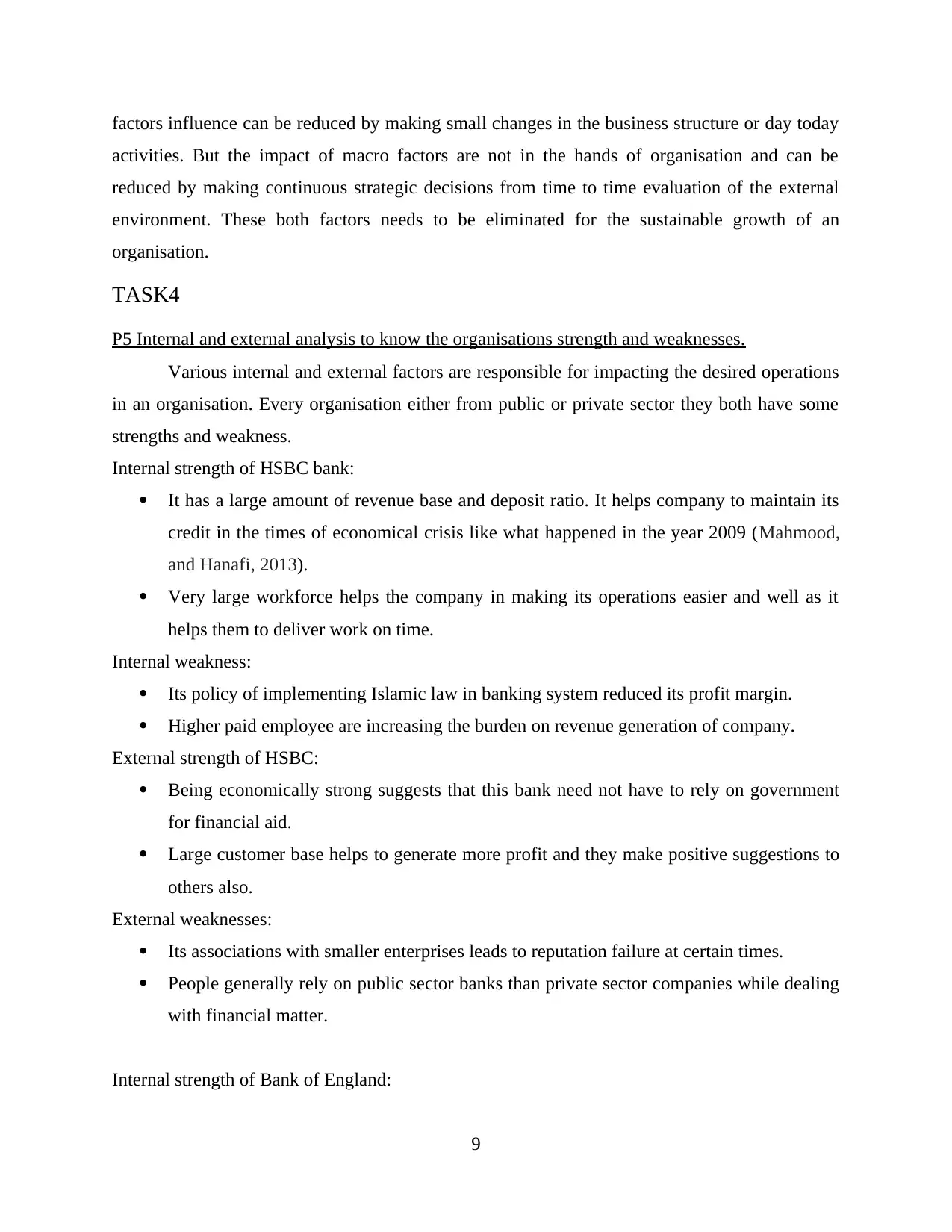
factors influence can be reduced by making small changes in the business structure or day today
activities. But the impact of macro factors are not in the hands of organisation and can be
reduced by making continuous strategic decisions from time to time evaluation of the external
environment. These both factors needs to be eliminated for the sustainable growth of an
organisation.
TASK4
P5 Internal and external analysis to know the organisations strength and weaknesses.
Various internal and external factors are responsible for impacting the desired operations
in an organisation. Every organisation either from public or private sector they both have some
strengths and weakness.
Internal strength of HSBC bank:
It has a large amount of revenue base and deposit ratio. It helps company to maintain its
credit in the times of economical crisis like what happened in the year 2009 (Mahmood,
and Hanafi, 2013).
Very large workforce helps the company in making its operations easier and well as it
helps them to deliver work on time.
Internal weakness:
Its policy of implementing Islamic law in banking system reduced its profit margin.
Higher paid employee are increasing the burden on revenue generation of company.
External strength of HSBC:
Being economically strong suggests that this bank need not have to rely on government
for financial aid.
Large customer base helps to generate more profit and they make positive suggestions to
others also.
External weaknesses:
Its associations with smaller enterprises leads to reputation failure at certain times.
People generally rely on public sector banks than private sector companies while dealing
with financial matter.
Internal strength of Bank of England:
9
activities. But the impact of macro factors are not in the hands of organisation and can be
reduced by making continuous strategic decisions from time to time evaluation of the external
environment. These both factors needs to be eliminated for the sustainable growth of an
organisation.
TASK4
P5 Internal and external analysis to know the organisations strength and weaknesses.
Various internal and external factors are responsible for impacting the desired operations
in an organisation. Every organisation either from public or private sector they both have some
strengths and weakness.
Internal strength of HSBC bank:
It has a large amount of revenue base and deposit ratio. It helps company to maintain its
credit in the times of economical crisis like what happened in the year 2009 (Mahmood,
and Hanafi, 2013).
Very large workforce helps the company in making its operations easier and well as it
helps them to deliver work on time.
Internal weakness:
Its policy of implementing Islamic law in banking system reduced its profit margin.
Higher paid employee are increasing the burden on revenue generation of company.
External strength of HSBC:
Being economically strong suggests that this bank need not have to rely on government
for financial aid.
Large customer base helps to generate more profit and they make positive suggestions to
others also.
External weaknesses:
Its associations with smaller enterprises leads to reputation failure at certain times.
People generally rely on public sector banks than private sector companies while dealing
with financial matter.
Internal strength of Bank of England:
9
⊘ This is a preview!⊘
Do you want full access?
Subscribe today to unlock all pages.

Trusted by 1+ million students worldwide
1 out of 19
Related Documents
Your All-in-One AI-Powered Toolkit for Academic Success.
+13062052269
info@desklib.com
Available 24*7 on WhatsApp / Email
![[object Object]](/_next/static/media/star-bottom.7253800d.svg)
Unlock your academic potential
Copyright © 2020–2025 A2Z Services. All Rights Reserved. Developed and managed by ZUCOL.




